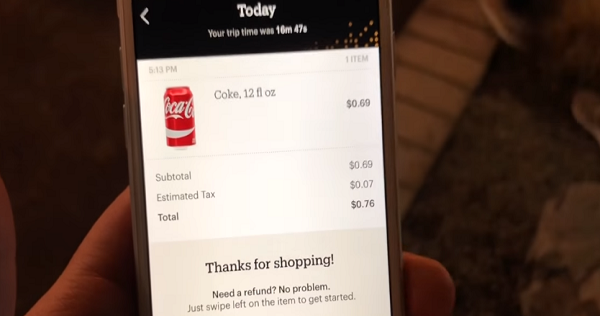
The real life Apu Nahasapeemapetilon’s of the convenience store universe, women and men, who are the heroes in dealing with every type of situation and person in a daily grind marked by lottery tickets, packs of cigarettes and gas and of course intermixed with a little gun play, are in the process of being selected by a series of complex and innovative sensors, software programs, and most importantly, a nice selection of products, thanks to a push by CEO Jeff Bezos and staff in testing retail outlets, featuring a completely automated checkout process. The real question is, what do the robots think about all of this, and how will their descendants react to a burgeoning technocratic global society with the world population exceeding 10 billion souls?
The residents of Seattle are of course the guinea pigs for the bold experiment of the Amazon brand name, competing in the short term against the 7-11’s and the Am-Pm’s, and smaller grocery stores, and featuring a store front where cash cannot buy admittance and all products selected are automatically linked to a debit account tied to a user’s smart phone. It is all about embracing and fostering the importance of instant gratification. No, nothing can go wrong here.
On the surface the concept is simple. The consumer uses an app on their smartphone or device to gain admittance to the Amazon Go grocery location and then things get spooky. Outnumbered by apparent smart technology, featuring facial recognition technology developed in China, customers are free to “shop” for a selection of ready to eat, prepackaged and staple food items and drink items. Once an item is selected from the shelves, the plethora of integrated circuits and social networking grade algorithms determine that a potential sale has been made and log the transaction. To correct the potential mistake of charging an individual for putting a product back, the customer’s account is not officially debited until they exit the premises. (Sorry. They do not accept cryptocurrencies.) For all the teenagers, who hope to use mom or dad’s smartphone to purchase booze, and for the sake of humanity, the corporation employs a sole human presence, to ensure that the liquor laws are not being violated. (Actually, there are and handful employees on site at the flagship location, though the number is expected to be significantly less than a similar sized outlets as the business model grows.) Whether or not the technology can determine if one is past the point of intoxication to refuse service, is still a burning concern, especially in the homeless haven situation of downtown Seattle, which is officially endorsed by the city council with the tax burden squarely on middle class and the sequined collared ‘tude of the hipsters.
Geekwire.com reports that the initial opening of the storefront featured lines around the block and customers enjoying a convenient experience with no obvious glaring technological glitches marring an otherwise nondescript Pacific Northwest winter day. The price points of products allegedly met the basic consumer standards and no WTO riot erupted due to a $4 cup of Top Ramen noodles, or a Kenny G. sighting.
In the wake of Amazon unleashing a powerful merchandising formula, wrapped in the glimmering digital blanket of an app, the crucial issue which is lost in the shuffle of pixelation and virtual reality, is that the leaders in the grocery and retail industries continue to gravitate towards an automated framework of operations, a proportionate number of jobs become obsolete. While the cost saving benefits of a reduced workforce are evident, where does this leave the economy and the job market over the next two decades, as the second largest pool of workers in the nation is diminished by the increased prevalence of technology that does not require a human presence?
As usual the detractors from reality use the classic specious reasoning logic that change is inevitable and through out history, humanity has been able to successfully adapt. With hundreds of thousands of manufacturing jobs lost to ultra efficient production line robots over the past ten years, the warning bells should be ringing that an Amazon-style deployment of smart retails outlets, may cause an irreversible chain reaction in effectively eliminating the unskilled worker from the context of the economy. Most people are not trained to code software or repair robotic systems. In no way does the outsourcing of telephone operators or gas station attendants, compare to the potential epic socioeconomic impact of millions of jobs over a short period of time being replace by smart systems and robots. When self-driving cars are unleashed in the wake of the current nightmare of hybrids, with a last bastion of hope in attempting to provide for a family, who will deliver pizzas in eeking out living. Well, certainly not a human being. And this is just what the self-aggrandizing tech community wants, as the ultimate bargaining chip in creating and controlling more government infrastructure in being in position to “rescue” the plausible massive hordes of men and women replaced by a clinical, calculated, and chilling upgrade to the workforce, which doesn’t require breaks and is prone to the attacks of criminal hackers. The irony is that Amazon will continue to gladly accept revenue generated from a diverse economic group of consumers, however with the current pathway leading towards towards the pending obliteration of massive employment opportunities, is the company just another victim to a robot dominated future?
Read the Geekwire.com story here.